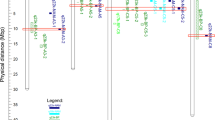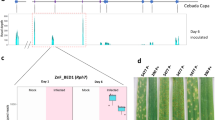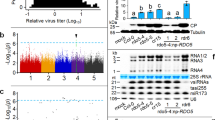Abstract
The mounting evidence that R genes incur large fitness costs raises a question: how can there be a 5–10% fitness reduction for all 149 R genes in the Arabidopsis thaliana genome? The R genes tested to date segregate for insertion–deletion (indel) polymorphisms where susceptible alleles are complete deletions. Since costs of resistance are measured as the differential fitness of isolines carrying resistant and susceptible alleles, indels reveal costs that may be masked when susceptible alleles are expressed. Rps2 segregates for two expressed clades of alleles, one resistant and one susceptible. Plants with resistant Rps2 are not less fit than those with a susceptible Rps2 allele in the absence of disease. Instead, all alleles provide a fitness benefit relative to an artificial deletion because of the role of RPS2 as a negative regulator of defence. Our results highlight the interplay between genomic architecture and the magnitude of costs of resistance.
This is a preview of subscription content, access via your institution
Access options
Subscribe to this journal
Receive 12 digital issues and online access to articles
$119.00 per year
only $9.92 per issue
Buy this article
- Purchase on Springer Link
- Instant access to full article PDF
Prices may be subject to local taxes which are calculated during checkout




Similar content being viewed by others
References
Tian, D., Araki, H., Stahl, E., Bergelson, J. & Kreitman, M. Signature of balancing selection in Arabidopsis. Proc. Natl Acad. Sci. USA 99, 11525–11530 (2002).
Bakker, E., Toomajian, C., Kreitman, M. & Bergelson, J. A genome-wide survey of R gene polymorphisms in Arabidopsis. Plant Cell Online 18, 1803–1818 (2006).
Thrall, P. et al. Rapid genetic change underpins antagonistic coevolution in a natural host-pathogen metapopulation. Ecol. Lett. 15, 425–435 (2012).
Brown, J. & Tellier, A. Plant-parasite coevolution: Bridging the gap between genetics and ecology. Annu. Rev. Phytopathol. 49, 345–367 (2011).
Brown, J. K. Durable resistance of crops to disease: a Darwinian perspective. Annu. Rev. Phytopathol. 53, 513–539 (2015).
Moreno-Gámez, S., Stephan, W. & Tellier, A. Effect of disease prevalence and spatial heterogeneity on polymorphism maintenance in host–parasite interactions. Plant Pathol. 62, 133–141 (2013).
Korves, T. & Bergelson, J. A novel cost of R gene resistance in the presence of disease. Am. Nat. 163, 489–504 (2004).
Tian, D., Traw, M. B., Chen, J. Q., Kreitman, M. & Bergelson, J. Fitness costs of R-gene-mediated resistance in Arabidopsis thaliana. Nature 423, 74–77 (2003).
Karasov, T. et al. The long-term maintenance of a resistance polymorphism through diffuse interactions. Nature 512, 436–440 (2014).
Grant, M., et al. Structure of the Arabidopsis RPM1 gene enabling dual specificity disease resistance. Science 269, 843–846 (1995).
Stahl, E. A., Dwyer, G., Mauricio, R., Kreitman, M. & Bergelson, J. Dynamics of disease resistance polymorphism at the Rpm1 locus of Arabidopsis. Nature 400, 667–671 (1999).
Rose, L., Atwell, S., Grant, M. & Holub, E. Parallel loss-of-function at the RPM1 bacterial resistance locus in Arabidopsis thaliana. Front. Plant Sci. 3, 287 (2012).
Meyers, B. C., Kozik, A., Griego, A., Kuang, H. & Michelmore, R. W. Genome-wide analysis of NBS-LRR-encoding genes in Arabidopsis. Plant Cell 15, 809–834 (2003).
Kunkel, B., Bent, A., Dahlbeck, D., Innes, R. & Staskawicz, B. RPS2, an Arabidopsis disease resistance locus specifying recognition of Pseudomonas syringae strains expressing the avirulence gene avrRpt2. Plant Cell Online 5, 865–875 (1993).
Yu, G. L., Katagiri, F. & Ausubel, F. Arabidopsis mutations at the RPS2 locus result in loss of resistance to Pseudomonas syringae strains expressing the avirulence gene avrRpt2. Mol. Plant Microbe Interact. 6, 434–443 (1993).
Mauricio, R. et al. Natural selection for polymorphism in the disease resistance gene Rps2 of Arabidopsis thaliana. Genetics 163, 735–746 (2003).
Bergelson, J. & Purrington, C. B. Surveying patterns in the cost of resistance in plants. Am. Nat. 148, 536–558 (1996).
Raj, A. & Rifkin, S. Variability in gene expression underlies incomplete penetrance. Nature 463 913–918 (2010).
Mindrinos, M., Katagiri, F., Yu, G. L. & Ausubel, F. M. The A. thaliana disease resistance gene RPS2 encodes a protein containing a nucleotide-binding site and leucine-rich repeats. Cell 78, 1089–1099 (1994).
Tao, Y., Yuan, F., Leister, R. T., Ausubel, F. M. & Katagiri, F. Mutational analysis of the Arabidopsis nucleotide binding site-leucine-rich repeat resistance gene RPS2. Plant Cell 12, 2541–2554 (2000).
McNellis, T. W., Mudgett, M. B., Li, K. & Aoyama, T. Glucocorticoid-inducible expression of a bacterial avirulence gene in transgenic Arabidopsis induces hypersensitive cell death. Plant J. 14, 247–257 (1998).
Leister, R. T. & Katagiri, F. A resistance gene product of the nucleotide binding site – leucine rich repeats class can form a complex with bacterial avirulence proteins in vivo. Plant J. 22, 345–354 (2000).
Banerjee, D., Zhang, X. & Bent, A. The leucine-rich repeat domain can determine effective interaction between RPS2 and other host factors in Arabidopsis RPS2-mediated disease resistance. Genetics 158, 439–450 (2001).
Axtell, M. J., McNellis, T. W., Mudgett, M. B., Hsu, C. S. & Staskawicz, B. J. Mutational analysis of the Arabidopsis RPS2 disease resistance gene and the corresponding pseudomonas syringae avrRpt2 avirulence gene. Mol. Plant Microbe Interact. 14, 181–188 (2001).
Day, B. et al. Molecular basis for the RIN4 negative regulation of RPS2 disease resistance. Plant Cell Online 17, 1292–1305 (2005).
Day, B., Dahlbeck, D. & Staskawicz, B. NDR1 interaction with RIN4 mediates the differential activation of multiple disease resistance pathways in Arabidopsis. Plant Cell Online 18, 2782–2791 (2006).
Qi, D., DeYoung, B. & Innes, R. Structure-function analysis of the coiled-coil and leucine-rich repeat domains of the RPS5 disease resistance protein. Plant Physiol. 158, 1819–1832 (2012).
Bergelson, J., Kreitman, M., Stahl, E. A. & Tian, D. Evolutionary dynamics of plant R-genes. Science 292, 2281–2285 (2001).
Gan, X. et al. Multiple reference genomes and transcriptomes for Arabidopsis thaliana. Nature 477, 419–423 (2011).
Laine, A. L. & Tellier, A. Heterogeneous selection promotes maintenance of polymorphism in host–parasite interactions. Oikos 117, 1281–1288 (2008).
Guo, Y.-L. L. et al. Genome-wide comparison of nucleotide-binding site-leucine-rich repeat-encoding genes in Arabidopsis. Plant Physiol. 157, 757–769 (2011).
Vergunst, A. C., Jansen, L. E. & Hooykaas, P. J. Site-specific integration of Agrobacterium T-DNA in Arabidopsis thaliana mediated by Cre recombinase. Nucleic Acids Res. 26, 2729–2734 (1998).
Caicedo, A. L., Schaal, B. A. & Kunkel, B. N. Diversity and molecular evolution of the RPS2 resistance gene in Arabidopsis thaliana. Proc. Natl Acad. Sci. USA 96, 302–306 (1999).
Guttman, D. S. & Greenberg, J. T. Functional analysis of the type III effectors AvrRpt2 and AvrRpm1 of Pseudomonas syringae with the use of a single-copy genomic integration system. Mol. Plant Microbe Interact. 14, 145–155 (2001).
Czechowski, T., Stitt, M., Altmann, T., Udvardi, M. K. & Scheible, W.-R. R. Genome-wide identification and testing of superior reference genes for transcript normalization in Arabidopsis. Plant Physiol. 139, 5–17 (2005).
Cao, J. et al. Whole-genome sequencing of multiple Arabidopsis thaliana populations. Nature Genet. 43, 956–963 (2011).
Acknowledgements
We thank H. King, L. Merwin, C. Meyer, W. Muliyati, A. Olsen, N. Shakoor and T. Stewart for their assistance in the field; J. Greenberg for donation of strains for infection; P. Hooykaas for pSDM3110, M. Vetter for her high-throughput infection protocol; and B. Brachi, T. Karasov, M. Kreitman and L. Merwin for helpful discussions. This research was supported by NSF and NIH grants to J.B. and a grant from the National Natural Science Foundation of China to X.Q.S. (Grant no. 31470448).
Author information
Authors and Affiliations
Contributions
X.Q.S. created the allelic series; A.M., X.Q.S. and J.B. designed the experiments; A.M. conducted the experiments; J.B. conceived of the experiments; A.M. and J.B. wrote the paper.
Corresponding author
Ethics declarations
Competing interests
The authors declare no competing financial interests.
Supplementary information
Supplementary Information
Supplementary Methods, Supplementary References, Supplementary Figs 1–8 and Supplementary Tables 1–22. (PDF 1428 kb)
Rights and permissions
About this article
Cite this article
MacQueen, A., Sun, X. & Bergelson, J. Genetic architecture and pleiotropy shape costs of Rps2-mediated resistance in Arabidopsis thaliana. Nature Plants 2, 16110 (2016). https://doi.org/10.1038/nplants.2016.110
Received:
Accepted:
Published:
DOI: https://doi.org/10.1038/nplants.2016.110
This article is cited by
-
Structural dynamics of a plant NLR resistosome: transition from autoinhibition to activation
Science China Life Sciences (2020)
-
Navigating complexity to breed disease-resistant crops
Nature Reviews Genetics (2018)
-
Disease resistance: Not so costly after all
Nature Plants (2016)



